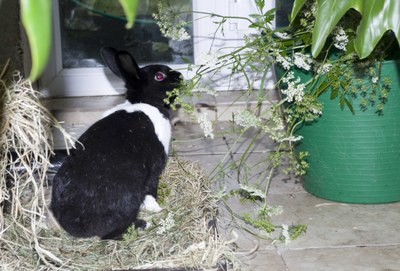FORAGING FOR WILD PLANTS
Rabbit have evolved to eat a wide range of plants including the shoots, roots, leaves, stems, flowers, fruit and seeds and foraging for wild plants to feed to pet rabbits has many benefits. However, there are some rules.
FORAGING RULES
|
Benefits of feeding wild plants
Wild plants are nutritionally balanced, palatable, and high in fibre. The plants that are picked are natural food for rabbits that they enjoy eating. Also the food is free. This is not good for the manufacturers of rabbit food that wish to sell their product. The information that the some manufacturers provides enhance the anxiety that owners feel when they pick wild plants. In reality, a diet of muesli mix or even pellets or nuggets is more likely to result in obesity or other health problems than a diet of wild plants.
Which plants to pick
Fresh grass is the natural diet of rabbits and grazing is their preferred method of feeding. Grass is easily picked. It is a source of digestible and indigestible fibre and is a balanced source of calcium and phosphorus. The moisture content provides water. Rabbits also enjoy a variety of other wild plants that can be found as garden weeds, along verges, footpaths, towpaths, river banks and bridleways. Hedgerows and waste ground are other places to look. The best approach is to pick a selection of four or five types of plant, including grass, that you recognise. Only pick plants that are growing in abundance. Illustrations of my favourite plants to forage can be seen here. Other wild plants that you may come across can be seen here.
 Disadvantages of foraging
Disadvantages of foraging
It is advisable to wear gloves when foraging because of the risk of being stung by nettles and some plants (e.g. dandelions) can stain your hands. There is also a risk of contamination by dog urine is unpleasant for the person picking the plants but does not pose any health risks. Contamination by dog or fox faeces is more of a problem because of the small risk of infection with tapeworm cysts.
Picking wild plants is a source of anxiety for many owners because of the perceived dangers of plant toxicity. In reality, there are very few plants that pose a real danger to rabbits and staying with plants that can be identified confidently will overcome the problem. The ability to identify plants to avoid also helps. A few stray leaves of an unfamiliar plant in the foraging mix are unlikely to be eaten.
 Weedkillers are another concern for owners. There is often a concern that the plants will have been sprayed. At one time, local councils would spray verges but that does not happen now. Occasionally landowners wish to spray verges or paths outside their property. If they have, it should be obvious that the plants are dead or dying (see picture). It is wise to pick plants that look healthy.
Weedkillers are another concern for owners. There is often a concern that the plants will have been sprayed. At one time, local councils would spray verges but that does not happen now. Occasionally landowners wish to spray verges or paths outside their property. If they have, it should be obvious that the plants are dead or dying (see picture). It is wise to pick plants that look healthy.
The risk of transmitting disease from wild rabbits is the most serious concern about foraging for pet rabbits. Rabbit Haemorrhagic Disease (RHD) is easily transmitted, not only via forage, but also on footwear or via insects, crows or foxes. The best way to protect rabbits is to vaccinate them and it is vital that tabbits that are fed on forage are vaccinated against RHD and RHDV2.

